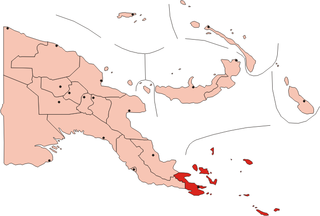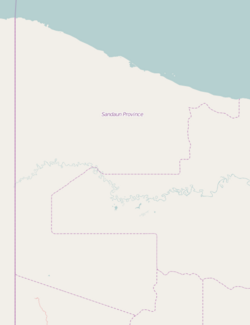
The Louisiade Archipelago is a string of ten larger volcanic islands frequently fringed by coral reefs, and 90 smaller coral islands in Papua New Guinea.

Wewak is the capital of the East Sepik province of Papua New Guinea. It is located on the northern coast of the island of New Guinea. It is the largest town between Madang and Jayapura. It is the see city (seat) of the Roman Catholic Diocese of Wewak.

Aitape is a small town of about 18,000 people on the north coast of Papua New Guinea in the Sandaun Province. It is a coastal settlement that is almost equidistant from the provincial capitals of Wewak and Vanimo, and marks the midpoint of the highway between these two capitals. Aitape has 240 V power, telephone, a bank, a post-office, a courthouse and a police station, a supermarket and many tradestores, a petrol station, two airstrips, two secondary schools, a mission office and a hospital.

The Battle of Driniumor River, also known as The Battle of Aitape, 10 July – 25 August 1944, was part of the Western New Guinea campaign of World War II. Japanese forces attacked United States forces on the Driniumor River, near Aitape in New Guinea. The battle should not be confused with Operation Persecution, which included amphibious landings near Aitape in April 1944, or the Aitape-Wewak campaign, which began in November. The Japanese referred to the Driniumor as the Hanto.

The Western New Guinea campaign was a series of actions in the New Guinea campaign of World War II. Dutch East Indies KNIL, United States and Australian forces assaulted Japanese bases and positions in the northwest coastal areas of Netherlands New Guinea and adjoining parts of the Australian Territory of New Guinea. The campaign began with Operations Reckless and Persecution, which were amphibious landings by the U.S. I Corps at Hollandia and Aitape on 22 April 1944. Fighting in western New Guinea continued until the end of the war.

The name Battle of Aitape or Aitape campaign may refer to any one of three military actions in proximity to Aitape in the Western New Guinea campaign of 1944-45:

The Battle of Hollandia was an engagement between Allies of World War II and Japanese forces during World War II. The majority of the Allied force was provided by the United States, with the bulk of two United States Army infantry divisions being committed on the ground. Air and naval support consisted largely of U.S. assets, although Australia also provided air support during preliminary operations and a naval bombardment force.

The Landing at Aitape was a battle of the Western New Guinea campaign of World War II. American and Allied forces undertook an amphibious landing on 22 April 1944 at Aitape on northern coast of Papua New Guinea. The amphibious landing was undertaken simultaneously with the landings at Humboldt and Tanahmerah Bays to secure Hollandia to isolate the Japanese 18th Army at Wewak. Operations in the area to consolidate the landing continued until 4 May, although US and Japanese forces fought further actions in western New Guinea following a Japanese counter-offensive that lasted until early August 1944. Aitape was subsequently developed into an Allied base of operations and was used by Australian forces throughout late 1944 and into 1945 during the Aitape–Wewak campaign.

The Aitape–Wewak campaign was one of the final campaigns of the Pacific Theatre of World War II. Between November 1944 and the end of the war in August 1945, the Australian 6th Division, with air and naval support, fought the Imperial Japanese 18th Army in northern New Guinea. Considered a "mopping up" operation by the Australians, and although ultimately successful for them with the Japanese forces cleared from the coastal areas and driven inland, amidst difficult jungle conditions, casualties from combat and disease were high. With Japan on the verge of defeat, such casualties later led to the strategic necessity of the campaign being called into question.

Kiwai Island is the largest island in the Fly River delta, Papua New Guinea. It is 59 km long along the northwest-southeast axis from Wamimuba Point in the northwest to the village of Saguane (Sanguane) in the south, and up to 9 km wide, with an average width of 5.6 km. Its area is 359 km². Neighboring Purutu and Wabuda Islands to the north and northeast are also among the three largest islands in the Fly River delta. A language study mentioned a population of about 4500, but the census of population of 2000 showed only 2092 inhabitants.
Gerald Leon Endl was a United States Army soldier and a recipient of the United States military's highest decoration—the Medal of Honor—for his actions in World War II.
Tadji is a small town on the north coast of Papua New Guinea in Aitape Urban ward of East Aitape Rural LLG, Sandaun Province. Tadji is located to the east of Aitape. The town is home to Tadji Airport, which was built by the Japanese in 1942 during the World War II. The liberation of Tadji was the focus of Operation Persecution during April 1944, when the Allies captured the airstrip.
Abuʼ, also known as Ua, is an Arapesh language of Papua New Guinea. Speakers are shifting to Tok Pisin.
Yakamul, also known as Kap or Ali, is an Austronesian language spoken in East Aitape Rural LLG, Sandaun Province, Papua New Guinea. It is spoken in the village of Yakamul on the north coast and on the islands of Ali, Angel, and Seleo islands.
Ulau-Suain is an Austronesian language of coastal Sandaun Province, Papua New Guinea. It is spoken in Ulau 1, Ulau 2, and Suain wards of East Aitape Rural LLG, Sandaun Province.
Tumleo is an Austronesian language of coastal Sandaun Province, Papua New Guinea, on Tumleo Island and the Aitape coast in East Aitape Rural LLG.

The Takenaga incident was a surrender by an Imperial Japanese Army battalion that occurred on 3 May 1945, near the end of the Pacific War. The battalion, commanded by Lieutenant Colonel Masaharu Takenaga, surrendered to the Australian Army in eastern New Guinea. This was extremely unusual for the Japanese Army, where surrender was seen as highly dishonourable.

East Aitape Rural LLG is a local-level government (LLG) of Sandaun Province, Papua New Guinea. Arapesh and Schouten languages are spoken in this LLG.
West Aitape Rural LLG is a local-level government (LLG) of Sandaun Province, Papua New Guinea. The Piore River languages and Oceanic languages such as Sissano are spoken in the LLG.
Uni (Ramo) is a Skou language of Papua New Guinea. It is spoken in Ramo village of West Aitape Rural LLG, Sandaun Province, located near the border with Indonesia.













